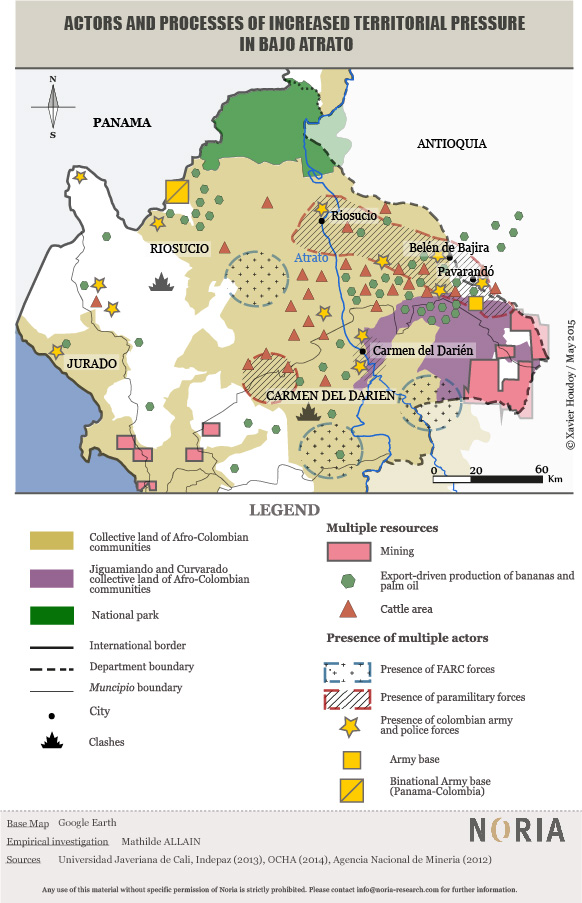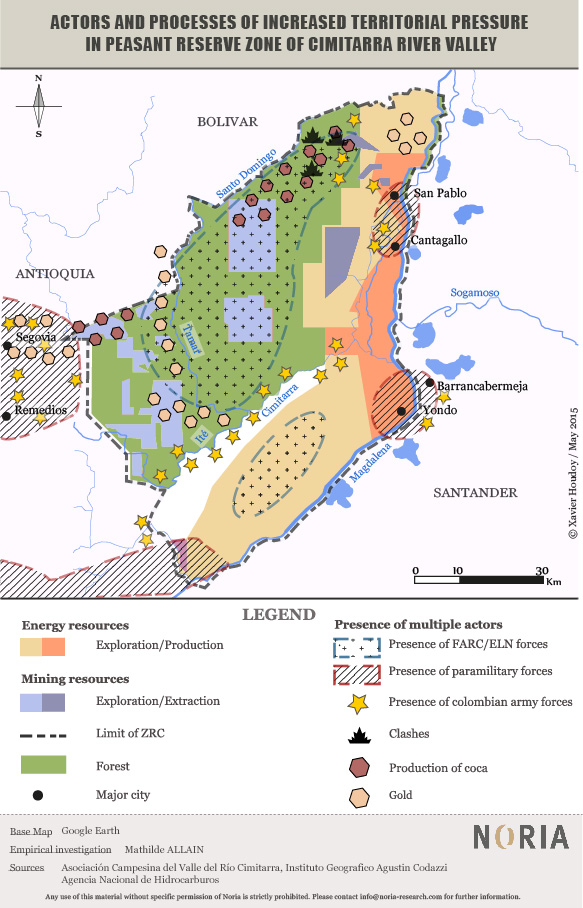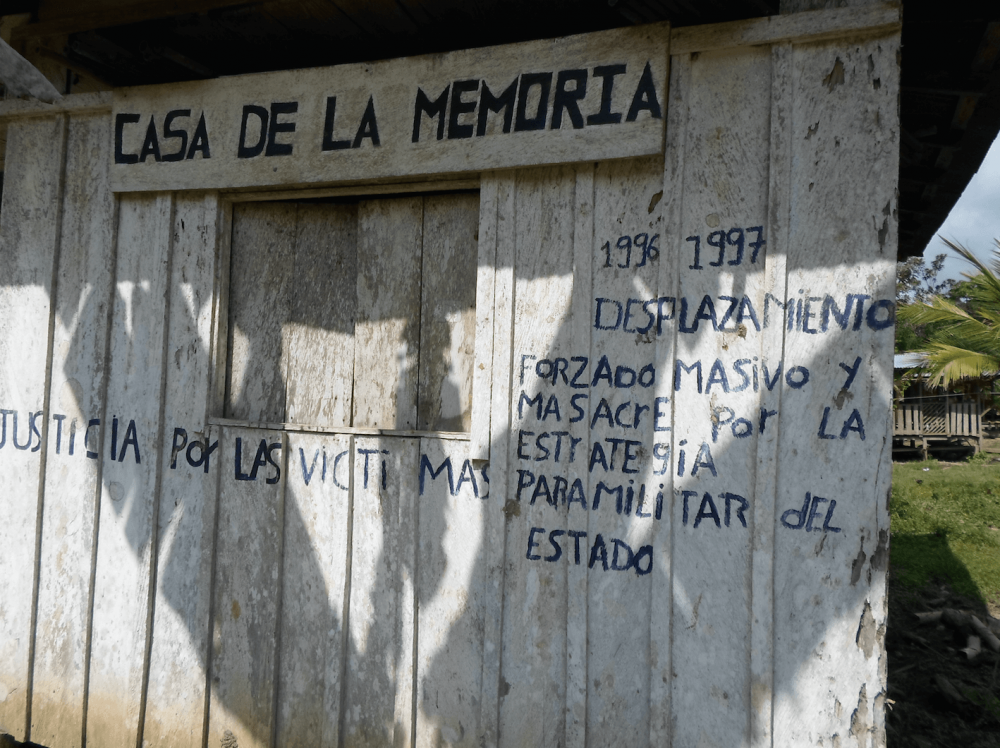In November 2014, the FARC (Revolutionary Armed Forces of Colombia) managed, rather surprisingly, the best take of their history: a general of the Colombian army, captured in the Chocó department 1 . Newly re-elected in June 2014, Juan Manuel Santos then immediately suspended the peace talks taking place since 2012 in Havana between the guerrilla and the government. What could have provoked a crisis for the peace process was only a jolt; once the general was freed, the negotiations could restart. However, this event brought forward a paradox: a peace negotiation in Cuba without a ceasefire in Colombia. It is certain that these negotiations bear, as a consequence of their ambition, a historical weight: solving a sixty year-old conflict, reinventing an agricultural policy, reintegrating the fighters and guaranteeing political participation for the opposition, coming up with a reparation policy for the thousands of victims and the five million-plus displaced, on top of the ceasefire and disarmament modalities. The first results show important headway, and the process is supported by an important part of the Colombian population 2 , which has shown its desire to end a conflict that started in the 1960s. However, the population did not hesitate either to express its fears towards the economic orientations taken by the Juan Manuel Santos government, as demonstrated by the many strikes of the peasant sector in 2013 against the free trade treaties3.
De facto, the countryside has gone through a mobilisation of unprecedented scale, to shed visibility on an agrarian conflict which remains still as tangible in the marginalised rural zones in comparison with the economic centres of the country. This marginalisation and the historical imbrication of political and agricultural issues in Colombia, have led to the coupling of peace negotiations with land issues. Although Juan Manuel Santos insured his re-election in June 2014 by positioning himself in the peace camp, his other offers have aroused controversies, notably his economic development plan around “development locomotives”, based on resource extraction. Whilst the peace negotiations offer to discuss the agricultural policy, the great extraction projects have already started in Colombia. This extractive dynamic has increased tensions on the parts of the territory which concentrate a multitude of armed actors: guerrillas, drug traffickers, paramilitaries, organised criminal gangs; all attracted by the resources (gold, charcoal, coltan, nickel, silver, zinc, molybdenum, platinum, etc.) and the renewed potential of Colombian lands, in particular for agro-fuel exports. In this context, the paramilitary groups and the criminal gangs are busying around the agricultural, mining and energy resources through new land grabbing strategies. Even if the enthusiasm around the peace process is real at the national level, it has to be contrasted with the local context which is the focus of this article, through the analysis of two strategic regions: the Bajo Atrato and the Magdalena Medio 4 .
New Land Grabbing Strategies
In the Bajo Atrato region (Chocó department), a particular strategy is implemented for the grabbing of resources and more precisely of fertile lands. In the two neighbouring basins affected by the mass displacements of 1997, the afro-descending communities of Jiguamiandó and Curvaradó are today experimenting the process of return to their lands. Placed under a collective property regime of the afro-descending communities by the 1993 bill, these territories are, in principle, under the responsibility of community councils. However, following the departure of 70% of the population, and despite the desire of displaced families organised in councils to retake their lands, these returns clash in practice with the business owners who settled during the displacement and who are little inclined to renounce these very fruitful investments. Indeed, large scale projects implemented by national and international corporations, some under State funding note] The Colombian government of Alvaro Uribe Vélez, as well as the one of his successor Juan Manuel Santos, were seduced by the rapid expansion of agro-fuels and have partly subsidised productions such as African palm or sugarcane to produce ethanol, through programs such as Agro Ingreso Seguro, in charge of allocating subsidies to farmers. This program, conceived by the former Agriculture minister Andrés Felipe Arias during the Alvaro Uribe Vélez government, was involved in numerous corruption and resource allocation scandals to large land owners and public personalities. The former minister was himself sentenced to 17 years of prison in 2014 for misappropriation of funds. [/mfn] , have invested thousands of hectares for cattle production and for African palm and plantain banana plantations for exportation. With close ties with the different paramilitary groups (when they are not themselves members of such groups 5), these business owners offer the community councils (often newly constituted) “strategic alliances”: the peasants regain their lands and continue to produce for the same business by selling it the production. But many community councils are opposed to these new forms of exploitation of populations and to these new types of contracts which are paramount to land leasing for quasi-infinite periods of time. Faced with this important social mobilisation headed by the historic leaders of the Jiguamiandó and Curvaradó basins, the paramilitaries have focused on the legal representation of these community councils. Through co-optation and threats, they push for the election of members more inclined to maintain the ties with these businesses in the name of the economic development of this zone. Once they control the representation of the communities, they thus ensure the continuity of their project and extend their territorial control. The expanding banana, palm and cattle productions thus continue in total impunity on the lands of the communities and the connivance between administrations and local police, businesses and paramilitaries, slow down the eviction orders, although they are acted by the Colombian justice. From there, a real process of legalisation of dispossession takes place, where local administrations do not carry out the judicial measures taken against these illegal occupants. This dispossession goes further still in the cases where businesses which illegally occupy these lands file complaints for invasion on personal property against the native communities who have property titles over their territory.

The Magdalena Medio region, historical bastion of peasant and workers struggles, is going through a similar type of land grabbing, notably via the presence of paramilitaries within the administrations. This paramilitary hold – which began in the late 1990s when these groups entered the city of Barrancabermeja, first oil port of the country situated in the banks of the Magdalena River – has since then changed. Indeed, when they appeared in the 1980s, the paramilitary groups first identified as defenders of an anti-insurgency project supported by the large land owners and a part of the Colombian economic elite, in reaction to the guerrilla insurgency and the threats they represented. These armed groups then multiplied i6n the 1980s and 1990s by maintaining ambiguous relations with the Colombian armed forces and the drug traffickers, notably following the boom of coca in the 1980s. Gathered under the banner of the United Self-Defence Forces of Colombia (Autodefensas Unidas de Colombia, AUC), the paramilitaries started negotiations in 2003 with the government of Alvaro Uribe Vélez, leading to their demobilisation between 2003 and 2006. After 2006, these groups were reworked and the AUCs were divided into several “criminal gangs” (BACRIM – Bandas criminales). The demobilisation only partially took place, and many current criminal gangs are the direct heirs of the paramilitaries of the 1990s. They thus maintain the same territorial hold, and at times, the same name.
The takeover of Barrancabermeja by the latter between 1996 and 2003, and particularly of its working-class neighbourhoods, led to a bloody repression. Since the late 1990s, the paramilitaries had progressively followed the Magdalena River upwards since Puerto Boyacá, to finally take real social control of the town between 2000 and 2003. They settled in different neighbourhoods, and cleared the peripheral urban zones of the guerrilla. Social organisations, leftist opposition groups, community leaders, human right defenders and peasant and union leaders were particularly targeted by this repression which aimed at establishing the social and territorial control of these groups. Between 2000 and 2003 over 1000 murders and approximately 300 disappearances were counted in the city and its surroundings6 . These exactions were committed with the complicity of commandos of the Colombian army in charge of the fight against drug trafficking, and more precisely with the 07 network of the Colombian army intelligence services 7 . Since then, the paramilitaries have reinforced their hold on the region, and notably on the strategic zones: Yondó and its oil fields, Remedios and its gold, the coca fields of San Pablo and the fertile lands of the Cantagallo municipality. After gaining control of the urban zones, the terror also spread to the countryside where legitimate violence is often confused with paramilitary violence. The “democratic security”8 has directly affected the peasant organisations suspected of feeding the enemynote] In Magdalena Medio, the paramilitaries and the Colombian army would establish punctual blockades on roads and rivers until the late 2000s, thus blocking all goods, fuel, and medication to the villages, accusing the peasants of provisioning the guerrilla.[/mfn] when they are not accused of thinking the same way. Since 2003, social organisations have been affected by judicial violence with fake trials against ztheir members. At the same time, the peasants have often been the first victims of the said “false positives”, assassinations of civilians who are then disguised to appear as guerilleros killed in combat 9. However, the mass and visible acts of violence (massacres, murders, forced displacements, systematic destruction of private property) have been gradually replaced by subtler and less obvious strategies. Indeed, paramilitary groups have gradually politicised – notably las Aguilas Negras, los Rastrojos, los Serafines, los Urabeños – in the sense that they have progressively taken over the administrations and decision-making bodies at the local level since the late 2000s. Whilst beforehand they controlled these political arenas through co-optation and threats, certain members now directly work within the administrations and municipal councils, where they seem to have swapped their fatigues for suits. By using the control they have over society and resources, they have progressively managed to get elected, or to position themselves in the key jobs of the administration via their good politico-economic relationships with the local political elite. This rooting phenomenon of the paramilitary actors within the institutions 10 is best illustrated by the punctual alliances at the local level to obtain key positions, for example in the councils of Remedios and Segovia where the paramilitaries gangrene local politics. They thus manage budgets; decide upon social and economic investments in zones as strategic as they are underprivileged. Hence, in the Magdalena Medio region, many authorisations to explore and exploit the mines were given for protected territories, natural reserves or peasant reserve zones 11. Ever since, the oil businesses have pushed the limits of environmental authorisations further every day, whilst the inhabitants of municipalities such as Yondó – which is amongst the city councils receiving the highest royalties in the country – still do not enjoy decent public services.

Towards a Struggle for Political Representation
The struggle for land of the 1970s has progressively transformed into a struggle for territory with all the economic, social, environmental and cultural dimensions involved. With the transformation of paramilitary strategies, the territorial conflict has locally evolved into a struggle for political representation. The peasant organisations, which are historically mobilised in this political arena, must face the same violent actors as in the 1990s but who currently fight with legal political weapons. However, these new territorial control strategies do not imply a pacification of these strategic zones. Indeed, the paramilitaries navigate between political and criminal control; where political control is only made possible through its violent counterpart: intimidations, extortions, threats, selective murders and forced disappearances. However, these more latent violent acts are both less visible and less identifiable and are catalogued as common petty crime. Furthermore, it is important to keep in mind that the paramilitaries have been officially demobilised since the “Justice and Peace” bill, they no longer exist officially. The exactions thus become the acts of “criminal gangs”, that is: depoliticised, disorganised, with no strategic preoccupations whatsoever. The naming and shaming work of social organisations thus becomes much more complex. These new types of violence affect social organisations at their core – as they affect political representation – and develop in difficult socio-economic conditions, where the rural population is tempted into these partnerships with the businesses to obtain a supplementary income in these historically marginalised zones. Organising the struggle from the territory has become essential to leave behind the individual logics imposed in recent years by policies of formalisation and registration of land rights. Thus, the unification of local organisations is primordial to guarantee land security and the in situ permanent presence of peasants to face the greed of large corporations. The latter exercise their predation within real estate markets (pressure to sell or “strategic alliances”) or without (evictions and spoliations through military and paramilitary operations, State-given concessions to businesses on national lands occupied by peasants).
Even if the recent mobilisations, whether on agricultural issues or in favour of peace, have shown the important support of the population for the process undertaken, several questions remain unanswered, in particular for the rural populations who represent 32% of the nation. When will the fighting really stop? The last debates, as stormy as they were, between the president’s political camp and that of his predecessor Alvaro Uribe Vélez on a possible bilateral ceasefire clearly demonstrate all the difficulties involved in its implementation, and question the future role of an over-equipped army with a colossal budget which has been dreaming for decades of an illusory military victory. What will happen in the territories still under guerrilla control, knowing that the State is historically absent there and that it does not have the capacities (nor the will) to deploy a civilian presence in these highly stigmatised zones? What is to be done with the other groups which do not take part in the negotiations, notably the paramilitaries whose victims are received in Havana although these groups have been officially demobilised? Finally, peace begs the question of the guarantees given to the peasants on their territories, because whilst in Cuba land concentration is under discussion, in Colombia, land grabbing is taken new forms and is legalised.
Notes
- In November 2014, General Alzate and his team fell into the hands of the FARC guerrilla whilst they were following a project of development for the army in this zone, even though it had been declared a red zone. The FARC had never detained such a high graded military since their constitution in 1964. ↩︎
- This support was expressed through many mobilisations in favour of peace, notably since 2012. Peace was also at the centre of the presidential campaign of 2014 where Juan Manuel Santos imposed himself as the peace candidate, against Oscar Ivan Zuluaga who criticised the ongoing negotiations. ↩︎
- In August 2013, when the Colombian peasants rebelled in the name of “dignity”, they brought to the fore their opposition to the free-trade treaties signed with the United States (in May 2012) and with the European Union (in August 2013) which put Colombian peasants, little equipped and unsubsidised, in direct competition with the subsidised sectors of the North American and European agribusiness. ↩︎
- These analyses are based on several field trips between September 2012 and November 2014 in these two regions. For the case study, the focus is on the mobilisation of the two peasant organisations of these regions. The ACVC (Peasant Association of the Cimitarra River valley) was formed in 1998 in Magdalena Medio. It aims at defending the peasant reserve zone, the autonomy of development projects of communities and the economic, political and social rights of peasants. As for the Bajo Atrato region, this piece focuses on community councils of afro-descending communities of Jiguamiandó and Curvaradó with their populations gradually returning to their lands since the early 2000s. In order to guarantee their security and the claim of their rights on the territory, they have gathered around humanitarian zones. ↩︎
- In November 2014, a judge from Medellin sentenced sixteen business owners for “aggravated crime in organised gang”, “forced displacement” and “invasion of areas of specific ecological importance”. However, in 2014, these businesses still controlled 20% of the collective territories of both communities. The main businesses that were condemned were Palmas de Curvaradó S.A., Palmura S.A., Palmas de Bajirá S.A., Inversiones Agropalma & Cia Ltda and Palmadó Ltda. Previously, the judicial apparatus had already touched upon the ambiguous relationships between certain paramilitary chiefs, notably Vicente Castaño, and palm businesses, as well as the strategies implemented to take control over land in this region. ↩︎
- Cinep/Credhos, 2004, Barrancabermeja, la otra versión, Caso tipo 3, Informe Noche y Niebla. ↩︎
- Interview with members of the Credhos (Corporación Regional para la defensa de los derechos humanos: Regional Corporation for the Defence of Human Rights), 2013. ↩︎
- Political slogan of the security-oriented policy of Alvaro Uribe Vélez. ↩︎
- Soldiers from the Colombian regular army attracted by the promised rewards for the death of guerrilleros thus murdered peasants and later disguised them into military targets. ↩︎
- Grajales Jacobo, 2009, Privatisation de la violence et formation de l’État. Le cas du phénomène paramilitaire en Colombie, Research Master’s Thesis Ecole Doctorale de Sciences Po, IEP Paris. ↩︎
- The peasant reserve zones are the result of a territorial planning constituted by the 160 bill of 1994, which, in chapter XIII, defines them as a special property regime. These zones aim at protecting peasant agricultures from land grabbing for intensive production (traditional latifundio), the agribusiness and the energy-mining sector. These are zones regulated to favour small scale entrepreneurship and autonomy in project management by the communities. Colombia has six constituted peasant reserve zones and over fifty are in the process of constitution. ↩︎

